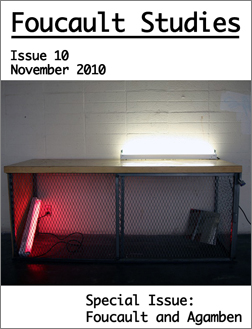The Allegory of the Cage: Foucault, Agamben, and the Enlightenment
DOI:
https://doi.org/10.22439/fs.v0i10.3124Abstract
This article reconsiders the relations between Immanuel Kant and Michel Foucault’s essays on the Enlightenment and adds Giorgio Agamben’s essay “What is an Apparatus?” to this constellation. It explores, specifically, the relations between Foucault’s definition of enlightenment and the central notion of Agamben’s philosophy: potentiality. The relation between potentiality and enlightenment is then mobilized in the article in the context of a discussion of technology in Kant, Foucault, and Agamben. What might be the relevance of the relation between Foucault’s enlightenment and Agamben’s potentiality for our understanding of technological developments today? The article engages with this question through a discussion of Foucault’s writings on the care of the self, Agamben’s theory of art, and Bernard Stiegler’s work on technology. It closes with a discussion of an artwork that stages the dramatic relation between all of these texts.Downloads
Published
2010-11-01
How to Cite
de Boever, A. (2010). The Allegory of the Cage: Foucault, Agamben, and the Enlightenment. Foucault Studies, (10), 7–22. https://doi.org/10.22439/fs.v0i10.3124
Issue
Section
Special Issue on Foucault and Agamben
License
Authors retain copyright to their work, but assign the right of the first publication to Foucault Studies. The work is subject to a CC BY-NC-ND 4.0 license, but despite these restrictions, authors can take for granted that Foucault Studies will permit articles published in Foucault Studies to be translated or reprinted in another format such as a book providing a full reference is made to Foucault Studies as the original place of publication.



